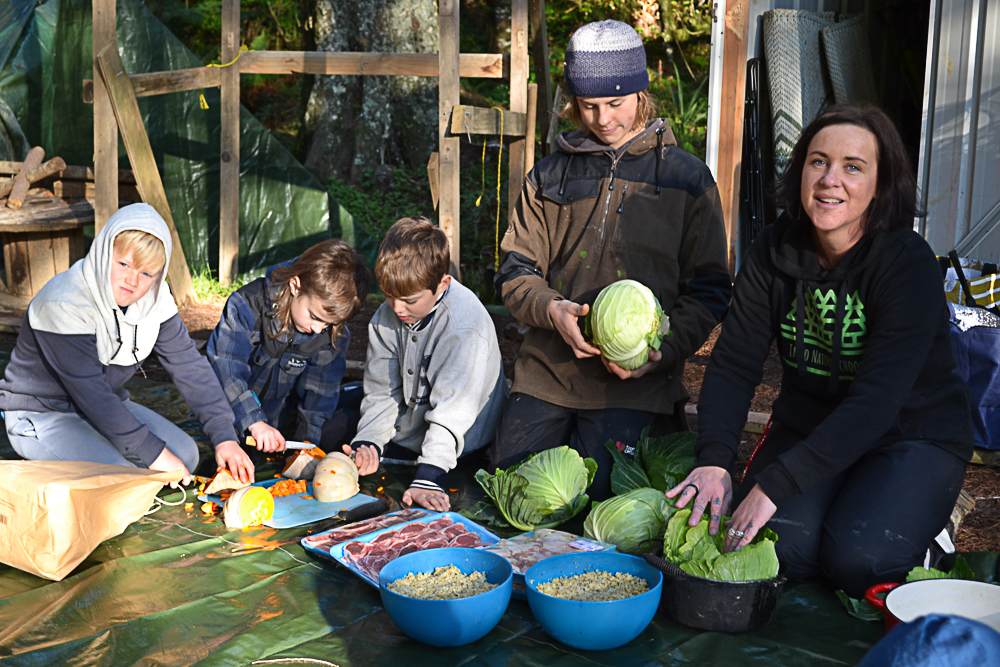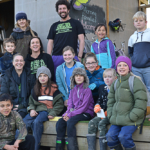It’s not unusual these days to come across a bunch of local pre-schoolers learning in the great outdoors, but a handful of Raglan parents are now also regularly going bush with their school-aged children to find a balance to what they see as a “cotton wool” world.
The bush in this case is a five-acre kahikatea forest at Te Pahu that’s effectively the giant-sized classroom of the aptly named ‘Into Nature School’. The fledgling school is accessed down a long, rutted farm track just off the Karamu horse trekking trail, and about the only nod to a traditional place of learning are a row of hooks for schoolbags and a makeshift chalkboard on their shed deck.
For one day a week during term time – and the whole of this first week of the school holidays – children converge here not only from Raglan but also from the likes of Pirongia, Te Awamutu, Te Kowhai and Hukanui.
They come already wearing gumboots as they’re quickly off into the forest, into nature, to experience “the things we all did as kids”, says school co-founder Amy Lake, who’s also a teacher and a deputy principal at nearby Whatawhata.
“We always have a firepit,” she told the Chronicle last Friday – the last day of term – as 25 or so 5-13 year olds headed towards the towering canopy of kahikatea and crouched like sprites among the tree roots on the gently sloping forest floor. “There’s always some element of food preparation and cooking.”
On Friday it was a firepit hangi to celebrate Matariki, the Maori New Year. All hands were on deck as the children helped carry wheelbarrowed-in firewood up to the spot where fellow teacher Eddie – who now lives in Te Uku but once ran a forest school in his native Spain – set the blaze alight.
The meat, veg and stuffing balls would steam in large, lidded cabbage leaf-lined pots for four hours, Eddie explained to the children. But first they’d help chop up all the vegetables, working together on a groundsheet spread over a flat part of the forest floor.
While they waited for the feast to cook they’d be busy turning empty tin cans into “fabulous” Matariki lanterns with tealight candles glowing inside, he said.
Hammer and nails were to be the tools of choice, he added, “or responsible people might be able to use the drills for holes”.
Some serious construction also goes on in the forest. Raglan teen Travis – whose younger sister Grace attends the school too – said he particularly liked “building things”, indicating the start of a changing room he and Eddie had erected for those wet change-of-clothes kind of days.
Travis and Grace’s cousins from Raglan, Pounamu and Anatipa, are also enrolled at the school, as is another Raglan lad who has learning difficulties and attends with his teacher’s aide.
This school environment is especially good for children with high sensory needs like ADHD, Amy explains. “They just blend in.”
The nature or forest school – as it’s also called – is the dream of Amy and her colleague Hillary Paalvast. Both primary trained, and each having taught in the Waikato for 18 years, they’d become somewhat disillusioned at seeing children enter the education system with low resilience and confidence.
So after being inspired on a professional development course by the success of New Zealand’s first forest school, set up in Hawke’s Bay, they went about creating a place where Waikato children too would have the opportunity to learn in the outdoors.
Finding a space was the “tricky” part, say the pair, who both live in Whatawhata. But as a result of their letterbox drops, a community-minded farmer who already hosted scout groups and motocross riders offered to lease his native forest block with a stream running through it.
“Once we found the spot it all lined up really nicely,” says Amy. ‘Into Nature School’ began one day a week back in January last year, with just 11 children including Amy’s youngest son.
The school’s “definitely grown”, she says – so much so that from next term it’ll be run two days a week, on Thursdays as well as Fridays. The teacher-to-child ratio is 1:10, she explains, and there’s no shortage of like-minded teachers to call on to help deliver those authentic real-life experiences, minus today’s digital devices.
Hillary, who once taught at Te Mata but is now based at Northern Health School in Hamilton, wishes her own two teens had still been young enough to attend when the nature school was set up.
As it is her children – along with Amy’s eldest two – get to help out during the school holiday programmes, which this week was to be all about children indulging their “wild side” by whittling arrows for a bow and making fire using a flint or steel.
Amy says their holiday programme is more geared towards fun in the outdoors, whereas weekdays during term time the focus is on specific educational needs.
Hillary adds that learning opportunities provided by the bush setting are limitless. She says the block is home for example to “the biggest, fattest kereru” or wood pigeons ever, and there are huge eels – named Godzilla and King Kong by the children – to be caught then released back into the stream.
All-weather survival skills are also a part of the diverse curriculum.
The two women say they have seen children lacking confidence in the outdoors, and sometimes lacking socially, turn very quickly into the kind of resilient individuals they imagined a nature school would nurture.
They’re totally convinced, as cited on their website, that “being immersed in nature is the greatest teacher and the ultimate healer”.
Edith Symes














